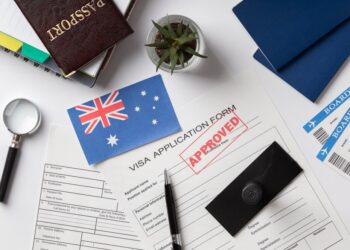Planning to visit Canada? Navigating the visa application process can be overwhelming, but fear not! In this comprehensive guide, we will break down the steps involved in obtaining a Canadian visa. Whether you’re a tourist, student, or worker, this step-by-step explanation will provide you with the knowledge and confidence needed to successfully secure your visa. From gathering the necessary documents to submitting your application, we’ve got you covered.
What Information About a Canadian Visas is Necessary?
Canada offers a wide range of visas, and each has its own set of requirements and processes. Understanding the specific details of the visa you’re applying for is crucial. Make sure to research the visa category thoroughly and gather all necessary documents. A Canada visa is an official document that allows you to enter Canada. It is a sticker that is placed on your passport. Most foreign nationals need a visa to visit Canada.
To apply for a Canada visa, you will need to provide a variety of information, including:
- Personal information: your name, date of birth, passport number, and contact information.
- Travel information: your travel plans, including the dates you plan to arrive and depart Canada, and the purpose of your visit.
- Financial information: proof that you have sufficient funds to support yourself during your stay in Canada.
- Medical information: a medical certificate confirming that you are in good health and do not have any contagious diseases.
- Police clearance certificate: a certificate from the police in your home country confirming that you have no criminal record.
In addition to the above, you may also need to provide additional information depending on the type of visa you are applying for. For example, if you are applying for a work visa, you will need to provide a letter of invitation from your employer. If you are applying for a study visa, you will need to provide a letter of acceptance from a Canadian educational institution.
How to Apply for a Canada Visa

You can apply for a Canada visa online or through the Canadian embassy or consulate in your home country.
To apply online, you will need to create an account on the Immigration, Refugees and Citizenship Canada (IRCC) website. Once you have created an account, you will be able to fill out the online visa application form.
To apply through the Canadian embassy or consulate, you will need to download and complete the paper visa application form. You can then submit the completed form and supporting documentation to the Canadian embassy or consulate in your home country.
Step 1: Determine the Type of Visa You Need
Canadian visas are divided into two main categories: temporary visas and permanent visas.
Temporary visas
Temporary visas allow you to visit, study, or work in Canada for a specific period of time. The most common types of temporary visas include:
- Visitor visa: This visa is for tourists and those visiting family and friends.
- Study permit: This visa is required if you plan to study in Canada for more than six months.
- Work permit: This visa is required if you want to work in Canada. There are many different types of work permits available, depending on the type of work you will be doing and your qualifications.
- Working Holiday visa: This visa allows young people from certain countries to work and travel in Canada for up to 12 months.
Permanent visas
Permanent visas allow you to immigrate to Canada and live there permanently. The most common types of permanent visas include:
- Express Entry: This is a system for skilled workers who want to immigrate to Canada permanently.
- Family sponsorship: This visa allows Canadian citizens or permanent residents to sponsor family members to immigrate to Canada.
- Provincial Nominee Program (PNP): Each province or territory has its own immigration program for nominating individuals for permanent residence.
The ease of obtaining a Canadian visa depends on various factors, including your qualifications, the visa category, and the specific requirements for that category. There’s no one-size-fits-all answer, and what might be “easier” for one person could be different for another. Visitor visas are often considered relatively straightforward for tourists.
Eligibility Criteria
The eligibility criteria for Canadian visas vary depending on the type of visa you are applying for. However, there are some general eligibility requirements that apply to all visa applicants, such as:
- Age requirements: Most visa applicants must be at least 18 years old.
- Educational background: Some visa categories have educational requirements.
- Language proficiency: Some visa categories have language proficiency requirements.
- For example, applicants for work permits must have the necessary skills and experience for the job they are applying for.
- Financial stability: You must show that you have enough money to support yourself during your stay in Canada.
Step 2: Gather Required Documents
Once you’ve identified the type of visa you need, you must gather the necessary documents. While the specific requirements may vary depending on the visa category, common documents include:
- Valid passport
- Passport-size photographs
- Proof of funds
- Educational documents (for study permits)
- Job offer letter (for work permits)
- Marriage certificate or birth certificates (for family sponsorship)
Ensure that your documents are up-to-date and translated into English or French if required.
Step 3: Complete the Application
Now, it’s time to complete the visa application. You can do this online through the Immigration, Refugees, and Citizenship Canada (IRCC) website. Carefully fill out the application form, and ensure that all required information and documents are attached.
Step 4: Pay the Application Fees
Each visa category comes with its own set of application fees, which must be paid during the application process. These fees are non-refundable, so it’s crucial to ensure that you meet the requirements before applying.
Step 5: Biometrics and Medical Examination
Depending on your country of residence and the type of visa, you may be required to provide biometric data (fingerprints and photograph) and undergo a medical examination. These requirements aim to ensure that applicants are in good health and admissible to Canada.
Step 6: Attend Interviews
For certain visa categories, such as study permits and work permits, you may be required to attend an interview at your local Canadian embassy or consulate. This is an opportunity for immigration officials to assess your application and ask questions.
Step 7: Wait for Processing
The processing times for Canadian visas can vary, but you can check the status of your application online. It’s important to be patient during this waiting period, as it can take several weeks or even months, depending on the visa category and your country of residence.
The processing time for Canada visas varies depending on the type of visa you are applying for and the country you are from. However, most visa applications are processed within 12 weeks.
Step 8: Receive a Decision
Once your application is processed, you will receive a decision from the Canadian authorities. If your application is approved, you will receive a Port of Entry (POE) Letter of Introduction and, if applicable, a temporary resident visa (TRV) or an electronic Travel Authorization (eTA).
Step 9: Plan Your Arrival
After receiving approval, it’s time to plan your arrival in Canada. Ensure you have all the required documents with you when you arrive. You may also need to demonstrate that you have the funds necessary to support yourself in Canada.
Once you have been admitted to Canada, you will need to take some initial settlement steps, such as:
- Finding a place to live
- Opening a bank account
- Obtaining a Canadian Social Insurance Number (SIN)
- Enrolling in healthcare
What is The Next Step after A Canada Visa is Approved?
After your Canada visa is approved, the next steps depend on the type of visa. For temporary visas like visitor visas, study permits, or work permits, you should plan your arrival and make sure you have all the necessary documents with you. For those obtaining permanent residency, you’ll need to complete the landing process and meet any conditions set by the Canadian government.
How to Increase Your Chances of Getting a Canada Visa

To increase your chances of getting a Canada visa, choose the right visa category, meet eligibility requirements, submit a complete and accurate application form, provide required documentation, and be honest and forthcoming in interviews. These include meeting age, education, language proficiency, work experience, and financial stability. Submit all necessary documents, including passport, application form, photos, processing fees, and proof of acceptance into a study program or job offer letter. Be forthcoming in interviews to assess your eligibility and determine your genuine visitor or worker.
Here are some additional tips that may help increase your chances of getting a Canada visa:
- Demonstrate strong ties to your home country. Canadian visa officers want to be sure that you will return to your home country after your visit to Canada. You can demonstrate strong ties to your home country by showing that you have a job or business, family, and property there.
- Have a clear and concise travel plan. When you apply for a Canada visa, you will be asked to provide a detailed travel plan. This includes your travel dates, your accommodation plans, and your activities in Canada. Make sure your travel plan is clear, concise, and realistic.
- Have a sufficient amount of funds. You will need to show that you have enough money to support yourself during your stay in Canada. The amount of money required will vary depending on the length of your stay and your lifestyle.
- Apply well in advance of your travel date. The processing time for Canadian visa applications can vary depending on the type of visa you are applying for and the country where you are applying from. It is best to apply for your visa well in advance of your travel date to avoid any delays.
Is a Canadian Visa easy for Indians?
Canada visas are generally easy for Indians to obtain, making them one of the top source countries for these visas. However, the process varies depending on the type of visa, individual circumstances, and current processing times.
To increase your chances of getting a Canadian visa from India, choose the right visa category, gather required documents, meet eligibility requirements, and be honest during interviews.
If you’re unsure about your eligibility or need help, consult a visa consultant or immigration lawyer. Additionally, ensure a valid passport and visa before travelling to Canada, be prepared to answer questions about your visit and ties to India, and have a clear financial plan for your stay.
What is The Minimum Bank Balance for A Canadian Visa?
There is no minimum bank balance requirement for a Canadian visa, but you will need to show that you have enough money to support yourself during your stay in Canada. This amount will vary depending on the length of your stay and your lifestyle.
Immigration, Refugees and Citizenship Canada (IRCC) recommends that visitors have at least CAD 1,000 per month for living expenses, plus the cost of their return transportation. If you are applying for a study permit, you will also need to show that you have enough money to pay for your tuition and other school-related expenses.
If you are applying for a work permit, you will need to show that you have enough money to support yourself until you find a job. IRCC recommends that work permit applicants have at least CAD 2,500 in savings.
You can show that you have enough money to support yourself by providing bank statements, proof of employment, or investment statements. You can also provide letters from family or friends who are willing to financially support you during your stay in Canada.
Keep in mind that the visa officer will assess your financial situation on a case-by-case basis. If you have a limited income or savings, you may still be able to obtain a visa if you have other factors that support your application, such as strong ties to your home country or a job offer in Canada.
In conclusion, the process of obtaining a Canadian visa involves several steps, and each visa category has its own set of requirements and processing times. To maximise your chances of success, it’s important to thoroughly research the specific visa you’re applying for, ensure that you meet all the requirements, and provide accurate and complete documentation. Additionally, consulting with immigration experts can provide valuable guidance throughout the application process, making your path to a Canadian visa more manageable.











